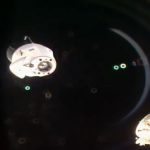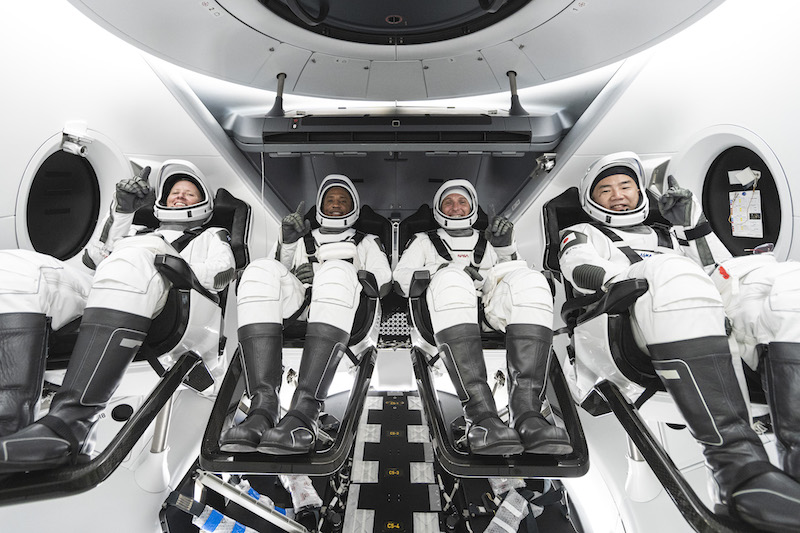
SpaceX made history again, when the private space company’s CRS-21 Cargo Dragon undocked from the Harmony module on the International Space Station (ISS) yesterday morning (January 12, 2021). It was the world’s first-ever autonomous (self-governing) undocking. The Cargo Dragon is expected to make its return to Earth later today, splashing down in the Gulf of Mexico after a roughly 36-hour journey.
Previous Cargo Dragon spacecraft were attached and removed from the space station using the station’s robotic Canadarm2. Yesterday’s undocking also marked the end of the first time two Dragons had been simultaneously docked to ISS. Today, the SpaceX Crew Dragon remains docked to ISS, still part of its current Expedition 64. The Crew Dragon will return to Earth later this year; more on that further down.
The 2021 lunar calendars are here! Going fast. Order yours before they’re gone!
Yesterday’s undocking of CRS-21 Cargo Dragon was broadcast live at 9:05 a.m. EST (14:05 UTC) via NASA’s streaming platform NASA TV. The undocking event had been originally scheduled for January 11, but bad weather at the spacecraft recovery zone prompted a one-day delay. Astronauts currently aboard the space station monitored the departure, including Victor Glover, a pilot on the first operational flight of the Crew Dragon. He bid farewell to the ship, exclaiming:
Godspeed, Cargo Dragon and to the recovery team.
The Cargo Dragon’s splashdown won’t be broadcast, but it’s sure to inspire discussion online about this recent change. Previously, all Dragon spacecraft splashed down in the Pacific Ocean, far away from the science processing center at NASA’s Kennedy Space Center in Florida. While not a bad receiving site, this posed complications that put time-critical science experiments at risk. Hauling the experiments from the landing site to the Kennedy Space Center could take hours to days at a time. Landing just off the western coast of Florida, however, could make the new turnaround time for experiment analysis as little as four hours after splashdown. NASA said in a statement:
On Wednesday, January 13, Dragon will conduct a deorbit burn at 7:37 p.m. [00:37 UTC January 14] to begin its re-entry sequence into Earth’s atmosphere. Dragon is expected to splash down west of Tampa off the Florida coast about 8:27 p.m. [01:37 UTC].
SpaceX staff assisting at the GO Navigator recovery ship will hoist the capsule aboard its deck after splashdown.
Another new feature introduced in this Cargo Dragon return is its upgraded size; it can carry up to 20% more cargo than earlier versions of the craft. The cargo to be recovered today includes 5,200 pounds (2,500 kg) of science experiments and other gear. According to Space.com, some of the returning experiments include investigations into cardiovascular cells, biofilms that could corrode stainless steel spacecraft structures, and techniques to assist with deep-space emergency navigation.
There will also be several small “passengers” onboard, if you count live mice, who are assisting with long-term studies into why astronaut eyesight changes in space.
Cargo Dragon is a supply ship with a design derived from SpaceX’s human-rated Crew Dragon vehicle. Crew Dragon brought Expedition 64’s international crew of four astronauts currently living on the ISS to the station, following a successful launch on the first NASA-certified commercial human spacecraft system in history. The NASA-SpaceX mission formally known as Crew-1 lifted off from the Kennedy Space Center on November 15, 2020. SpaceNews wrote that it set a number of record firsts: Glover is going to be the first black astronaut to make a long-duration ISS flight. Soichi Noguchi was the first Japanese astronaut to fly on three separate spacecraft into orbit: the shuttle, the Soyuz, and the Crew Dragon. The mission is the Federal Aviation Administration’s first commercially approved crewed orbital flight.

NASA astronauts (from left to right) Shannon Walker, Victor Glover, and Mike Hopkins, and astronaut Soichi Noguchi of the Japan Aerospace Exploration Agency — who constituted the crew of NASA’s Crew-1 mission — inside SpaceX’s Crew Dragon spacecraft. Image via NASA/SpaceX.
Upcoming events on SpaceX’s agenda include rocket launches, sky events, missions and more. While unknown how many of these plans will come to fruition in the new year, the son of the company’s CEO Elon Musk appears to have good feelings. Musk tweeted:
My 14-year-old son, Saxon, said he feels like 2021 will be a good year. I agree. Let us all make it so.
My 14-year-old son, Saxon, said he feels like 2021 will be a good year. I agree. Let us all make it so.
— Elon Musk (@elonmusk) January 9, 2021
Bottom line: SpaceX’s CRS-21 Cargo Dragon undocked from the International Space Station’s Harmony module yesterday morning, January 12, 2021, succeeding in the world’s first-ever autonomous undocking and testing of several new vehicle upgrades. This event also marks the end of the first time two Dragons were simultaneously docked to the ISS, as Expedition 64’s Crew Dragon remains docked to the orbiting complex to return to Earth later this year.
from EarthSky https://ift.tt/3oBOBGK

SpaceX made history again, when the private space company’s CRS-21 Cargo Dragon undocked from the Harmony module on the International Space Station (ISS) yesterday morning (January 12, 2021). It was the world’s first-ever autonomous (self-governing) undocking. The Cargo Dragon is expected to make its return to Earth later today, splashing down in the Gulf of Mexico after a roughly 36-hour journey.
Previous Cargo Dragon spacecraft were attached and removed from the space station using the station’s robotic Canadarm2. Yesterday’s undocking also marked the end of the first time two Dragons had been simultaneously docked to ISS. Today, the SpaceX Crew Dragon remains docked to ISS, still part of its current Expedition 64. The Crew Dragon will return to Earth later this year; more on that further down.
The 2021 lunar calendars are here! Going fast. Order yours before they’re gone!
Yesterday’s undocking of CRS-21 Cargo Dragon was broadcast live at 9:05 a.m. EST (14:05 UTC) via NASA’s streaming platform NASA TV. The undocking event had been originally scheduled for January 11, but bad weather at the spacecraft recovery zone prompted a one-day delay. Astronauts currently aboard the space station monitored the departure, including Victor Glover, a pilot on the first operational flight of the Crew Dragon. He bid farewell to the ship, exclaiming:
Godspeed, Cargo Dragon and to the recovery team.
The Cargo Dragon’s splashdown won’t be broadcast, but it’s sure to inspire discussion online about this recent change. Previously, all Dragon spacecraft splashed down in the Pacific Ocean, far away from the science processing center at NASA’s Kennedy Space Center in Florida. While not a bad receiving site, this posed complications that put time-critical science experiments at risk. Hauling the experiments from the landing site to the Kennedy Space Center could take hours to days at a time. Landing just off the western coast of Florida, however, could make the new turnaround time for experiment analysis as little as four hours after splashdown. NASA said in a statement:
On Wednesday, January 13, Dragon will conduct a deorbit burn at 7:37 p.m. [00:37 UTC January 14] to begin its re-entry sequence into Earth’s atmosphere. Dragon is expected to splash down west of Tampa off the Florida coast about 8:27 p.m. [01:37 UTC].
SpaceX staff assisting at the GO Navigator recovery ship will hoist the capsule aboard its deck after splashdown.
Another new feature introduced in this Cargo Dragon return is its upgraded size; it can carry up to 20% more cargo than earlier versions of the craft. The cargo to be recovered today includes 5,200 pounds (2,500 kg) of science experiments and other gear. According to Space.com, some of the returning experiments include investigations into cardiovascular cells, biofilms that could corrode stainless steel spacecraft structures, and techniques to assist with deep-space emergency navigation.
There will also be several small “passengers” onboard, if you count live mice, who are assisting with long-term studies into why astronaut eyesight changes in space.
Cargo Dragon is a supply ship with a design derived from SpaceX’s human-rated Crew Dragon vehicle. Crew Dragon brought Expedition 64’s international crew of four astronauts currently living on the ISS to the station, following a successful launch on the first NASA-certified commercial human spacecraft system in history. The NASA-SpaceX mission formally known as Crew-1 lifted off from the Kennedy Space Center on November 15, 2020. SpaceNews wrote that it set a number of record firsts: Glover is going to be the first black astronaut to make a long-duration ISS flight. Soichi Noguchi was the first Japanese astronaut to fly on three separate spacecraft into orbit: the shuttle, the Soyuz, and the Crew Dragon. The mission is the Federal Aviation Administration’s first commercially approved crewed orbital flight.

NASA astronauts (from left to right) Shannon Walker, Victor Glover, and Mike Hopkins, and astronaut Soichi Noguchi of the Japan Aerospace Exploration Agency — who constituted the crew of NASA’s Crew-1 mission — inside SpaceX’s Crew Dragon spacecraft. Image via NASA/SpaceX.
Upcoming events on SpaceX’s agenda include rocket launches, sky events, missions and more. While unknown how many of these plans will come to fruition in the new year, the son of the company’s CEO Elon Musk appears to have good feelings. Musk tweeted:
My 14-year-old son, Saxon, said he feels like 2021 will be a good year. I agree. Let us all make it so.
My 14-year-old son, Saxon, said he feels like 2021 will be a good year. I agree. Let us all make it so.
— Elon Musk (@elonmusk) January 9, 2021
Bottom line: SpaceX’s CRS-21 Cargo Dragon undocked from the International Space Station’s Harmony module yesterday morning, January 12, 2021, succeeding in the world’s first-ever autonomous undocking and testing of several new vehicle upgrades. This event also marks the end of the first time two Dragons were simultaneously docked to the ISS, as Expedition 64’s Crew Dragon remains docked to the orbiting complex to return to Earth later this year.
from EarthSky https://ift.tt/3oBOBGK

Aucun commentaire:
Enregistrer un commentaire